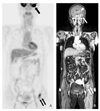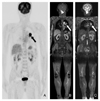References
1. Horvath LJ, Burtness BA, McCarthy S, Johnson KM. Total-body echo-planar MR imaging in the staging of breast cancer: comparison with conventional methods-early experience. Radiology 1999. 211119–128.
2. Walker R, Kessar P, Blanchard R, Dimasi M, Harper K, DeCarvalho V, Yucel EK, Patriquin L, Eustace S. Turbo STIR magnetic resonance imaging as a whole-body sc-reening tool for metastases in patients with breast car-cinoma: preliminary clinical experience. J Magn Re-son Imagin 2000. 11343–350.
3. Lauenstein TC, Goehde SC, Herborn CU, Goyen M, Ober-hoff C, Debatin JF, Ruehm SG, Barkhausen J. Whole-body MR imaging: evaluation of patients for metastases. Radiology 2004. 233139–148.
4. Yi CA, Shin KM, Lee KS, Kim BT, Kim H, Kwon OJ, Choi JY, Chung MJ. Non-small cell lung cancer staging: efficacy comparison of integrated PET/CT versus 3.0-T whole-body MR imaging. Radiology 2008. 248632–642.
5. Barkhausen J, Quick HH, Lauenstein T, Goyen M, Ruehm SG, Laub G, Debatin JF, Ladd ME. Whole-body MR imaging in 30 seconds with real-time true FISP and a continuously rolling table platform: feasibility study. Radiology 2001. 220252–256.
6. Thomson V, Pialat JB, Gay F, Coulon A, Voloch A, Granier A, Guerin JC, Viallon M, Berthezene Y. Whole-body MRI for metastases screening: a preliminary study using 3D VIBE sequences with automatic subtraction between noncontrast and contrast enhanced images. American journal of clinical oncology 2008. 31285–292.
7. Darge K, Jaramillo D, Siegel MJ. Whole-body MRI in children: Current status and future applications. Eur-opean journal of radiology 2008.
8. Daldrup-Link HE, Franzius C, Link TM, Laukamp D, Sciuk J, Jurgens H, Schober O, Rummeny EJ. Whole-body MR imaging for detection of bone metastases in children and young adults: comparison with skeletal scintigraphy and FDG PET. Ajr 2001. 177229–236.
9. Mazumdar A, Siegel MJ, Narra V, Luchtman-Jones L. Whole-body fast inversion recovery MR imaging of small cell neoplasms in pediatric patients: a pilot study. Ajr 2002. 1791261–1266.
10. Laffan EE, O'Connor R, Ryan SP, Donoghue VB. Whole-body magnetic resonance imaging: a useful additional sequence in paediatric imaging. Pediatric radiology 2004. 34472–480.
11. Goo HW, Choi SH, Ghim T, Moon HN, Seo JJ. Whole-body MRI of paediatric malignant tumours: comparison with conventional oncological imaging methods. Pediatric radiology 2005. 35766–773.
12. Lauenstein TC, Semelka RC. Emerging techniques: whole-body screening and staging with MRI. J Magn Reson Imaging 2006. 24489–498.
13. Althoff CE, Appel H, Rudwaleit M, Sieper J, Eshed I, Hamm B, Hermann KG. Whole-body MRI as a new screening tool for detecting axial and peripheral mani-festations of spondyloarthritis. Annals of the rheumatic diseases 2007. 66983–985.
14. Ladd SC, Debatin JF, Stang A, Bromen K, Moebus S, Nuefer M, Gizewski E, Wanke I, Doerfler A, Ladd ME, Benemann J, Erbel R, Forsting M, Schmermund A, Jockel KH. Whole-body MR vascular screening detects unsuspected concomitant vascular disease in coronary heart disease patients. European radiology 2007. 171035–1045.


